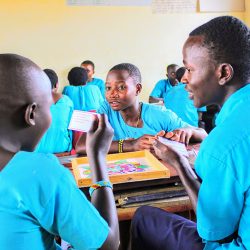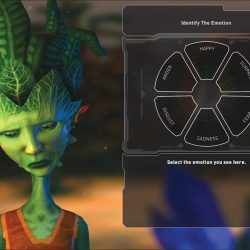Word Games
As America’s Hmong population grows, so does interest in its language.

Many of the UW students enrolled in Hmong classes grew up in the United States speaking English, but want to become fluent enough to be able to talk with parents and relatives in their native language. Photo: Bryce Richter
Pab Xiav and Pab Liab, also known as Team Blue and Team Red, are locked in a battle for supremacy. During several heated rounds of the game Guess Who?, team members take turns asking questions, trying to figure out which character is on the other team’s card. But there’s a catch: most of the exchanges are in the Hmong language, the focus for the nineteen students enrolled in LCA Language 307: First Semester Hmong.
Instructor Choua Lee often uses games, including Pictionary and Scrabble, in this beginning-level course, explaining, “You have to be able to be creative in any way to encourage the students to use the target language they are learning in class.”
While playing Guess Who?, the students are not allowed to use English, except for common words like “okay,” and Lee has replaced English names on the game pieces with names in Hmong. She intervenes when students need help, but most are on their own, answering questions with yog for “yes” or tsis for “no.” At one point, some of the students pantomime as they debate the words for “beard” and “mustache” before asking a question to home in on their guesses.
For much of the game, the students sit at the edge of their chairs, engrossed, cheering at victories and laughing heartily at their own mistakes as they struggle with the language. The game also ties into their next assignment: writing a journal entry describing one of their closest friends, including unique physical and personality characteristics.
UW-Madison began offering three levels of Hmong language classes in fall 2007; last fall, enrollment totaled sixty-four students. Most taking the classes are ethnically Hmong, but never became fluent. The “heritage” students, as they are called, also have little or no experience reading or writing the language, says Lee, a native Hmong speaker who moved to the United States as a teenager after spending her childhood in Laos and Thailand.
The U.S. Hmong population, which arrived from southern China and Southeast Asia primarily during the past twenty-five years, is estimated at more than 200,000, with 40,000 living in Wisconsin. For many of Lee’s students, the classes offer a chance to bridge the culture gap with their families after growing up in the United States.
Pilline Lee x’12, who plans to become a pediatrician, enrolled in the class so that she can talk to her parents without inserting English into the conversation. But she says being Hmong doesn’t make the class easier for her or any other heritage student.
“I knew that it would be somewhat challenging, but I never thought it would be so hard,” she says.
In Hmong, every tone has its own meaning, with the pitch of the speaker’s voice going up and down like a series of musical notes. The letter at the end of words dictates the tone used; for example, pob means ball, poj means female, and pog means grandmother. The most challenging part of the language is hearing the tones correctly and pronouncing the sounds of the consonants.
“There is no English equivalent sound for them to compare and contrast with,” Choua Lee says.
Amy Isensee x’10, a linguistics major who is working toward a certificate to teach English as a second language, decided to enroll in the class in light of America’s growing Hmong population. Isensee, who has also studied Spanish, French, and Mandarin Chinese, says, “Of the four, Hmong is definitely — hands down — the hardest language I’ve studied. The sounds … are unlike anything I’ve had to produce before.”
Published in the Spring 2009 issue



Comments
No comments posted yet.